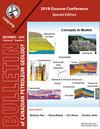Hypogenic karst beneath the Athabasca Oil Sands: Implications for oil sands mining operations
Q3 Earth and Planetary Sciences
引用次数: 11
Abstract
The Athabasca Oil Sands, located in northeast Alberta, largely comprise a stacked succession of Early Cretaceous fluvial and marine sediments that were deposited directly above Middle and Late Devonian limestones, dolostones, calcareous shales and evaporites. Dissolution of halite and anhydrite from the Prairie Evaporite Formation by hypogenic karstification has resulted in the diachronous subsidence of overlying stratigraphic units and severe brecciation of important aquitards. These aquitards are required to protect oil sands mining operations from in-pit influxes of saline water sourced from Devonian aquifers. Sequence stratigraphic, palynologic and groundwater isotopic evidence suggests that karstification began prior to the Early Cretaceous, was active during deposition of the McMurray Formation and is still ongoing today in the Athabasca Oil Sands mining area. Groundwater flow associated with hypogenic karstification has important implications for the development of the Athabasca Oil Sands. For in-situ projects, Devonian aquifers are considered both as a resource for the moderately saline water required for steam generation and as a disposal zone for waste water. In open-pit oil sands mines, some of the most effective aquitards are removed by mining operations, thereby increasing the possibility that saline water from the Devonian aquifers could enter the mine pits. This poses safety, environmental and economic risks to mining operations that require a thorough understanding of the geologic, hydraulic and geomechanical controls related to hypogenic karstification. This paper, presents our current understanding of the hypogenic karst system in the vicinity of the Kearl mine.阿萨巴斯卡油砂下的深生岩溶:对油砂开采作业的影响
阿萨巴斯卡油砂位于阿尔伯塔省东北部,主要由早白垩世河流和海洋沉积物的堆叠序列组成,这些沉积物直接沉积在中泥盆纪和晚泥盆纪石灰岩、白云岩、钙质页岩和蒸发岩之上。草原蒸发岩组的岩盐和硬石膏因地下岩溶作用而溶解,导致上覆地层单元的跨时沉降和重要弱透水层的严重角砾化。这些弱透水层是为了保护油砂开采作业不受来自泥盆纪含水层的盐水流入的影响。层序地层学、孢粉学和地下水同位素证据表明,岩溶作用始于早白垩世,在McMurray组沉积期间很活跃,至今仍在阿萨巴斯卡油砂矿区进行。与地下岩溶作用有关的地下水流对阿萨巴斯卡油砂的开发具有重要意义。对于现场项目,泥盆纪含水层既被视为蒸汽产生所需的中等盐水资源,也被视为废水处理区。在露天油砂矿中,一些最有效的弱透水层通过采矿作业被去除,从而增加了泥盆纪含水层的盐水进入矿井的可能性。这给采矿作业带来了安全、环境和经济风险,需要彻底了解与地下岩溶作用有关的地质、水力和地质力学控制。本文介绍了我们目前对Kearl矿附近地下岩溶系统的理解。
本文章由计算机程序翻译,如有差异,请以英文原文为准。
求助全文
约1分钟内获得全文
求助全文
来源期刊

Bullentin of Canadian Petroleum Geology
Earth and Planetary Sciences-Geochemistry and Petrology
CiteScore
2.50
自引率
0.00%
发文量
0
期刊介绍:
The Bulletin of Canadian Petroleum Geology is a peer-reviewed scientific journal published four times a year. Founded in 1953, the BCPG aims to be the journal of record for papers dealing with all aspects of petroleum geology, broadly conceived, with a particularly (though not exclusively) Canadian focus. International submissions are encouraged, especially where a connection can be made to Canadian examples.
 求助内容:
求助内容: 应助结果提醒方式:
应助结果提醒方式:


